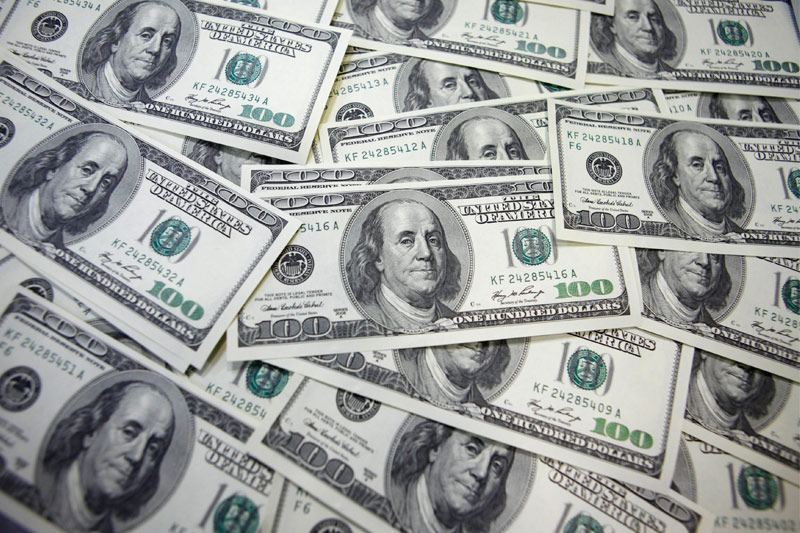Investing.com - The dollar rose against most major currencies on Thursday after U.S. growth and jobless claims numbers beat expectations and boosted expectations for the Federal Reserve to begin winding down monetary stimulus programs possibly next month.
In U.S. trading on Thursday, EUR/USD was down 0.38% at 1.3341.
The Commerce Department reported earlier that the U.S. gross domestic product expanded at an annual rate of 2.5% in the second quarter, above expectations for 2.2% growth and up from a preliminary estimate of 1.7%.
Separately, the Department of Labor reported that the number of individuals who filed for initial jobless claims fell to its lowest level since October of 2007 last week.
Initial jobless claims in the week ending Aug. 23 fell by 6,000 to 331,000, outpacing consensus forecasts for a decline of 5,000.
Thursday's data rekindled expectations that the Federal Reserve may begin to taper its USD85 billion monthly bond-buying program in September as opposed to later in the year.
Monetary stimulus tools such as Federal Reserve asset purchases weaken the dollar by driving down interest rates, and talk of their dismantling strengthens the greenback.
The dollar also saw continued safe-haven demand from investors who remained wary over the possibility of a U.S.-led military strike against Syria’s government following its alleged use of chemical weapons, although an attack seemed less imminent on Thursday due to complaints from U.S. lawmakers that they have not been properly consulted.
The euro, meanwhile, saw pressure on concerns that Greece may require a third bailout package in 2014.
Also weakening the single currency, Germany reported that the number of people out of work climbed by 7,000 to 2.95 million, defying market calls for a decline of 5,000.
The country's unemployment rate remained unchanged at 6.8%
The pound, meanwhile, continued to see pressure after Bank of England Governor Mark Carney said earlier this week that monetary authorities were ready to boost stimulus programs if investor expectations for higher interest rates reach the point that they undermine recovery.
Carney has said BoE policy makers plan to keep the benchmark interest rate at a record-low 0.5% for at least three years though improving U.K. economic indicators have many betting that rates may rise sooner than expected
The greenback was up against the pound, with GBP/USD down 0.13% at 1.5508.
The dollar was up against the yen, with USD/JPY up 0.61% at 98.24, and up against the Swiss franc, with USD/CHF trading up 0.94% at 0.9308.
The dollar was up against its cousins in Canada, Australia and New Zealand, with USD/CAD up 0.40% at 1.0530, AUD/USD down 0.08% at 0.8934 and NZD/USD trading down 0.31% at 0.7775.
The dollar index, which tracks the performance of the greenback versus a basket of six other major currencies, was up 0.67% at 81.98.
On Friday, the U.S. is to round up the week with a report on manufacturing activity in Chicago and revised data from the University of Michigan on consumer sentiment as well as reports on personal income and personal spending.
In U.S. trading on Thursday, EUR/USD was down 0.38% at 1.3341.
The Commerce Department reported earlier that the U.S. gross domestic product expanded at an annual rate of 2.5% in the second quarter, above expectations for 2.2% growth and up from a preliminary estimate of 1.7%.
Separately, the Department of Labor reported that the number of individuals who filed for initial jobless claims fell to its lowest level since October of 2007 last week.
Initial jobless claims in the week ending Aug. 23 fell by 6,000 to 331,000, outpacing consensus forecasts for a decline of 5,000.
Thursday's data rekindled expectations that the Federal Reserve may begin to taper its USD85 billion monthly bond-buying program in September as opposed to later in the year.
Monetary stimulus tools such as Federal Reserve asset purchases weaken the dollar by driving down interest rates, and talk of their dismantling strengthens the greenback.
The dollar also saw continued safe-haven demand from investors who remained wary over the possibility of a U.S.-led military strike against Syria’s government following its alleged use of chemical weapons, although an attack seemed less imminent on Thursday due to complaints from U.S. lawmakers that they have not been properly consulted.
The euro, meanwhile, saw pressure on concerns that Greece may require a third bailout package in 2014.
Also weakening the single currency, Germany reported that the number of people out of work climbed by 7,000 to 2.95 million, defying market calls for a decline of 5,000.
The country's unemployment rate remained unchanged at 6.8%
The pound, meanwhile, continued to see pressure after Bank of England Governor Mark Carney said earlier this week that monetary authorities were ready to boost stimulus programs if investor expectations for higher interest rates reach the point that they undermine recovery.
Carney has said BoE policy makers plan to keep the benchmark interest rate at a record-low 0.5% for at least three years though improving U.K. economic indicators have many betting that rates may rise sooner than expected
The greenback was up against the pound, with GBP/USD down 0.13% at 1.5508.
The dollar was up against the yen, with USD/JPY up 0.61% at 98.24, and up against the Swiss franc, with USD/CHF trading up 0.94% at 0.9308.
The dollar was up against its cousins in Canada, Australia and New Zealand, with USD/CAD up 0.40% at 1.0530, AUD/USD down 0.08% at 0.8934 and NZD/USD trading down 0.31% at 0.7775.
The dollar index, which tracks the performance of the greenback versus a basket of six other major currencies, was up 0.67% at 81.98.
On Friday, the U.S. is to round up the week with a report on manufacturing activity in Chicago and revised data from the University of Michigan on consumer sentiment as well as reports on personal income and personal spending.
